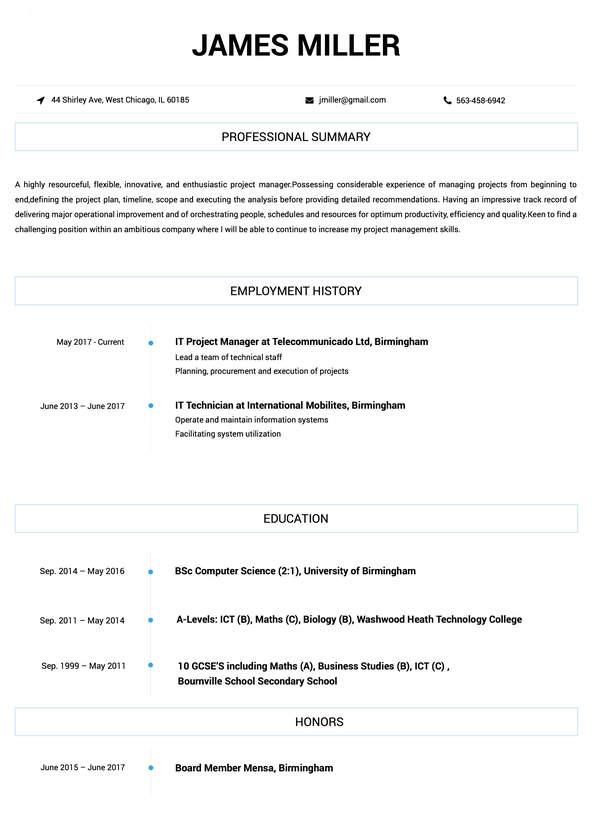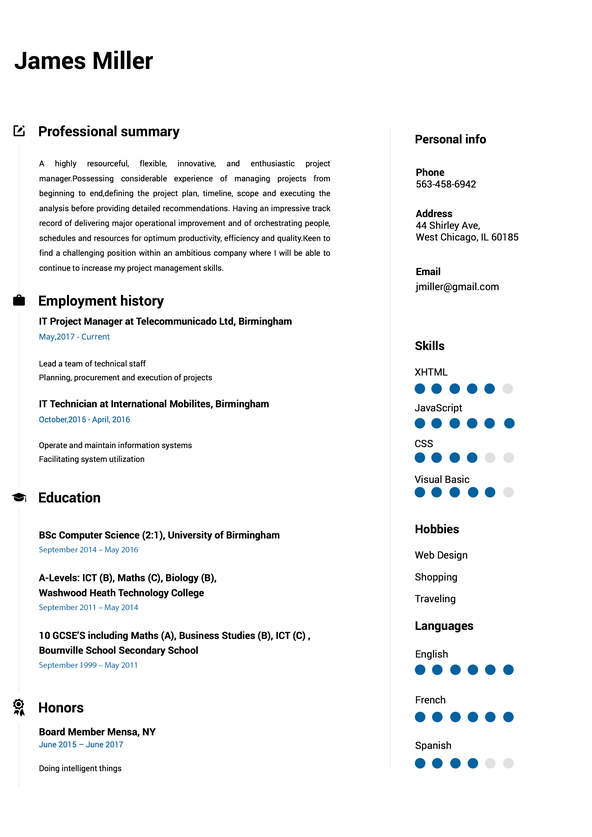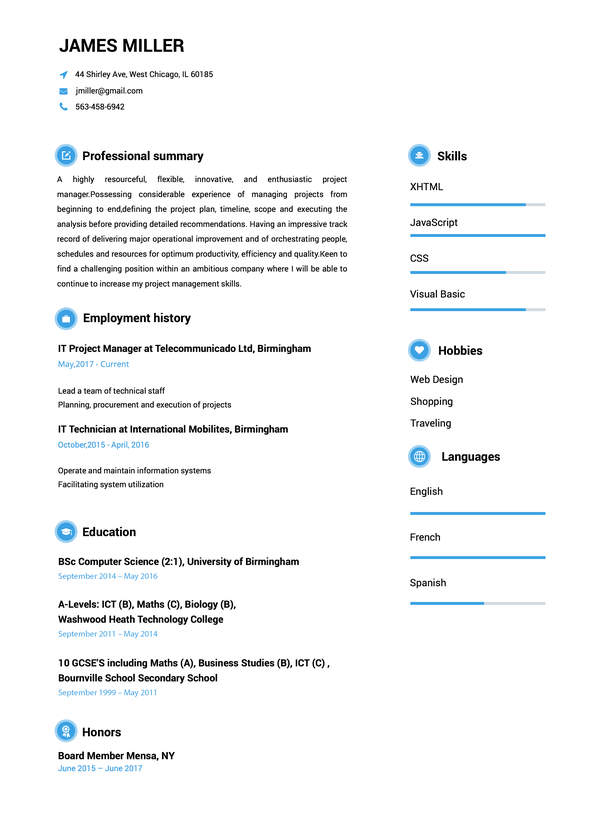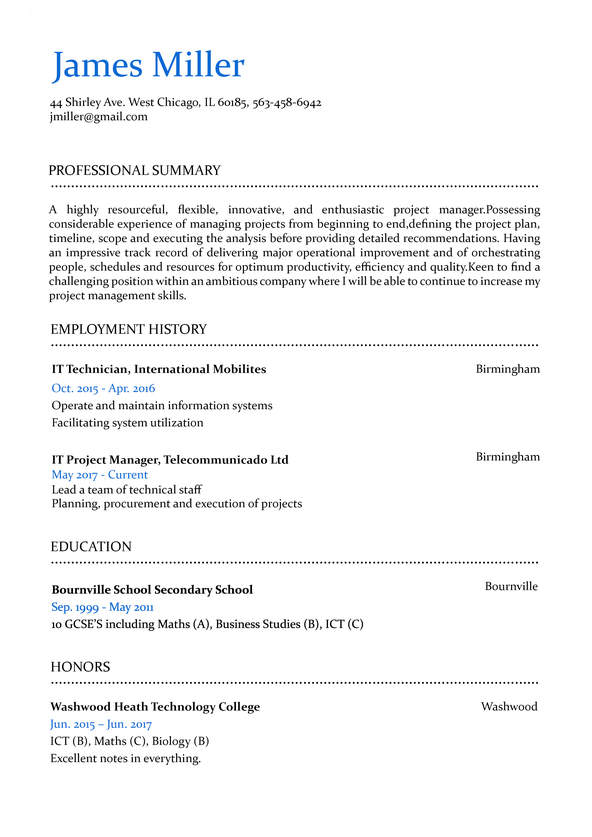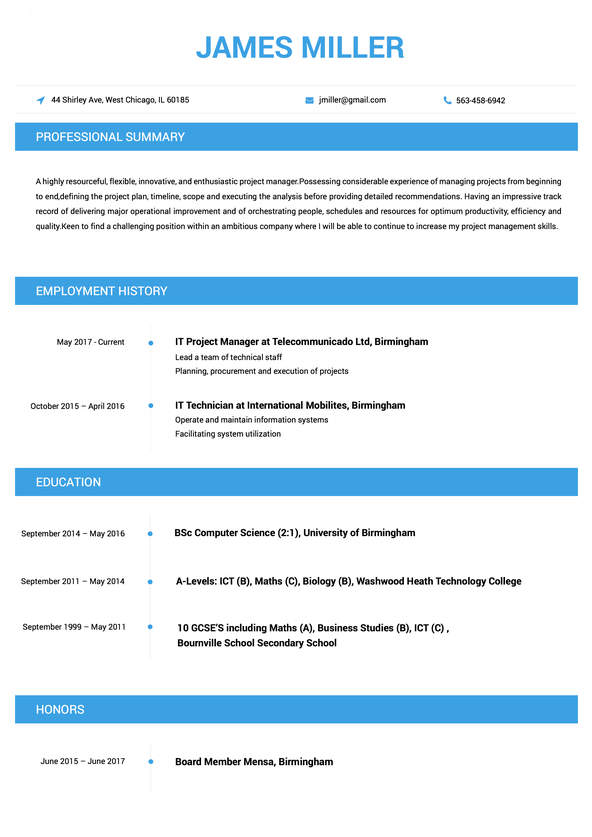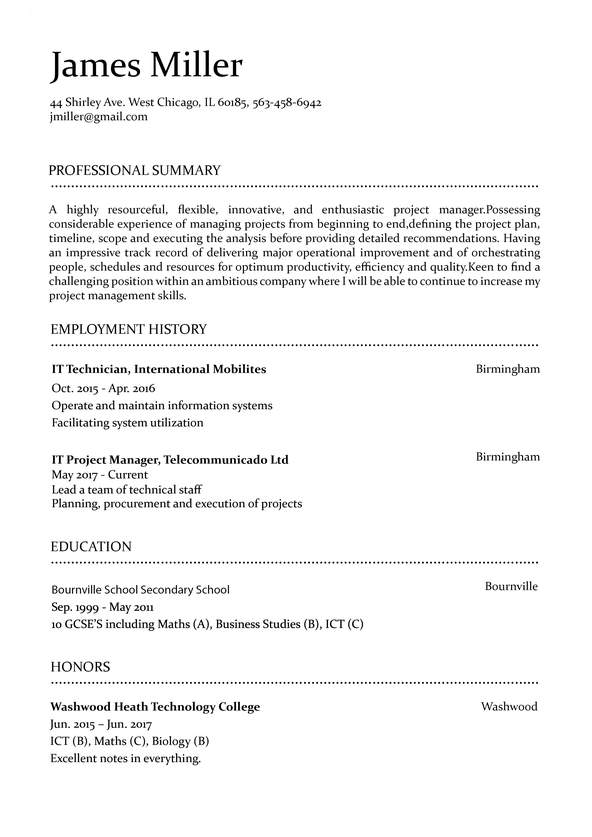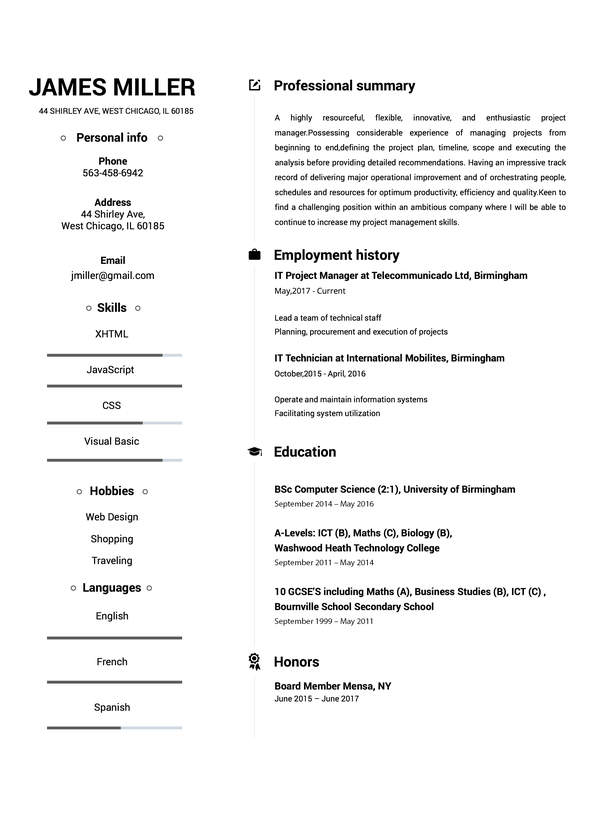 Use This Template
Use This Template 
Build your resume in 15 minutes
Create an awesome resume that meets the expectations of potential employers with our selection of professional, field-tested resume templates.
artist: Resume Samples & Writing Guide
Professional Summary
Employment history
- Collaborating with clients, printers, and other stakeholders to ensure successful completion of projects
- Creating storyboards and preparing final layouts
- Designing creative artwork, graphics, logos, illustrations, and other visuals
- Preparing rough drafts and presenting ideas
- Designing creative artwork, graphics, logos, illustrations, and other visuals
- Ensuring final graphics and layouts are visually appealing and on-brand
- Keeping abreast of emerging technologies in new media, particularly design programs such as InDesign, Illustrator, Photoshop, 3D Studio, etc
- Ensuring final graphics and layouts are visually appealing and on-brand
- Managing and maintaining a portfolio of work
Education
Skills
Do you already have a resume? Use our PDF converter and edit your resume.
Professional Summary
Employment history
- Managing and maintaining a portfolio of work
- Researching current design trends and emerging technologies
- Ensuring final graphics and layouts are visually appealing and on-brand
- Making necessary changes to finished designs and artwork
- Revising designs after feedback
- Researching current design trends and emerging technologies
- Designing creative artwork, graphics, logos, illustrations, and other visuals
- Preparing rough drafts and presenting ideas
- Utilizing software to create digital illustrations, logos, and other visuals
Education
Skills
Employment history
- Brainstorming and developing innovative ideas and concepts
- Meeting deadlines and staying within budget constraints
- Revising designs after feedback
- Creating storyboards and preparing final layouts
- Meeting with clients to discuss project objectives and requirements
- Collaborating with clients, printers, and other stakeholders to ensure successful completion of projects
- Creating storyboards and preparing final layouts
- Meeting deadlines and staying within budget constraints
- Ensuring final graphics and layouts are visually appealing and on-brand
Education
Skills
Employment history
- Revising designs after feedback
- Ensuring final graphics and layouts are visually appealing and on-brand
- Keeping abreast of emerging technologies in new media, particularly design programs such as InDesign, Illustrator, Photoshop, 3D Studio, etc
- Meeting with clients to discuss project objectives and requirements
- Collaborating with clients, printers, and other stakeholders to ensure successful completion of projects
- Researching current design trends and emerging technologies
- Designing creative artwork, graphics, logos, illustrations, and other visuals
- Researching current design trends and emerging technologies
- Meeting deadlines and staying within budget constraints
Education
Skills
Professional Summary
Employment history
- Creating storyboards and preparing final layouts
- Researching current design trends and emerging technologies
- Preparing rough drafts and presenting ideas
- Utilizing software to create digital illustrations, logos, and other visuals
- Making necessary changes to finished designs and artwork
- Revising designs after feedback
- Meeting deadlines and staying within budget constraints
- Developing concepts, graphics and layouts for product illustrations, company logos, and websites
- Designing creative artwork, graphics, logos, illustrations, and other visuals
Education
Skills
Not in love with this template? Browse our full library of resume templates
Are you looking to become the next Rembrandt? Or maybe Banksy is more your style? Or perhaps you want to establish yourself as a one-of-a-kind artist - the likes of which the art world has never seen before.
Whatever your vision is for your art career, with the right combination of skills, talent, and insider know-how, you’ll be able to achieve it.
However, it will take some hard work. As you may already know, being an artist is one of the most rewarding, but misunderstood professions out there. Despite the romantic vision of a carefree life that’s filled solely with creating art, the reality is quite different.
Creating art represents a substantial chunk of being an artist, but it’s only part of the story. Artists also need to attend to a range of other tasks, such as liaising with potential buyers, establishing connections with galleries, and organizing all of the materials, funding, and resources needed for their next artwork.
Most artists will agree that their love of art makes all of the hurdles along the way well worth it. It’s certainly a lot easier once you start making a name for yourself. So how do you start securing the jobs and exhibitions you’ve always dreamed of? Apply to them with a well-written artist resume.
You may not think it’s necessary for an artist to have a resume, but this couldn’t be further from the truth. Applying for jobs with a strong resume shows a hiring manager or gallery director that you’re a consummate professional, who offers a range of invaluable qualities. While in a perfect world, your art would speak for itself, companies, galleries, and other organizations will not only want to confirm that you’re a talented artist, but also that you hold the credentials they’re looking for.
In this easy-to-understand guide, we’ll show you how to make an artist resume that will get your inbox blowing up. If you’re unsure how to make an impactful one, this guide will cover everything you need to know including:
- How to correctly format your resume
- Which hard and soft skills to feature
- How to expertly include your portfolio in your resume
- What to do if you have little to no experience
- Tips to make your resume stand out from the pack
1. Multiple Template Examples
2. How to Write an Artist Resume That Will Get You Through the Doors?
How to format your resume properly
An artist resume is unlike the resumes of most other professions. After all, you not only need to include standard resume components, such as your professional experiences, but also feature special components, such as the exhibitions you’ve participated in.
That being said, you will still need a tried-and-tested format that makes your achievements shine. We strongly recommend that you use a reverse-chronological format.
In this format, you begin with your most recent professional experience, exhibition, or award, and from there proceed backwards. For example, your March 2020 exhibition should appear first, followed by your January 2020 exhibition, and so on.
The order each section should appear in your resume will depend on what you’re applying for. If you’re applying for a job (for example, curating an exhibition in an art gallery), your professional experience should be the first major section on your resume, followed by your exhibitions section. Then you can feature any additional sections after that, such as your awards section.
Whereas, if you are applying to be featured in an exhibition, your exhibitions section should be the first major section on your resume, followed by whichever section is most relevant to the exhibition application. For example, if you’re applying to exhibit in an abstract art gallery and you won an award for your abstract artwork, put that above your work experience stretching canvases in an art store.
- Number of Pages: 1 page only.
- Fonts to Use: Classic fonts such as Garamond or Arial.
- Fonts to Avoid: Don’t use any “arty” fonts that will take attention away from your achievements, such as Naive Deco Sans Font or any hand drawn fonts.
- Margins: 1 inch on all sides.
- Line Spacing: 1 or 1.15.
- Header size: 14-16 point size.
- Text size: 11-12 point size.
What makes a great artist resume?
A great artist resume paints a clear picture about who an artist fundamentally is as a professional. Your resume should offer whoever is reading it - whether the director of a gallery or a hiring manager - an overview of your most relevant and eye-catching accomplishments.
It should serve to compliment your artist portfolio by providing an insight into what makes you a unique artist, who is worth hiring or exhibiting. While an artwork is a creative representation of your skills and abilities, your resume will use words to shine a light on your most notable attributes.
After reading your resume, the hiring manager or gallery director should be convinced that you have the ideal educational background, skills, professional experiences, and reputation to excel in the position they’re trying to fill.
This is why the importance of refining your resume cannot be stressed enough. In the incredibly competitive world of art - where art related work positions are limited and spots in exhibitions are challenging to get - your resume needs to leave no doubt that you’re worth hiring or exhibiting over the hundreds to thousands of other applicants.
What hard skills and soft skills should you put in your resume as an artist?
Artists are well known for possessing a variety of artistic skills that non-artistic-types can only dream about having. These technical skills artists draw on to create their artworks are referred to as “hard skills” in a resume. Without a strong set of hard skills, an artist will struggle to take off in the art world.
Artists also need to possess so-called “soft skills” to succeed. A soft skill describes any type of intangible skill, which requires using your communication or interpersonal abilities. Someone with a strong soft skills set will be perceived as personable, organized, a good communicator, and hard working.
On your resume, you need to show that you offer an excellent balance of the soft and hard skills a hiring manager or gallery director is looking for. You will know which skills these are by identifying the skills they mention in a job ad or exhibition application.
You should ensure your resume incorporates these skills in three main sections, as noted below:
- Incorporate 1 to 2 skills into your resume objective or resume summary
- List 6 to 8 skill in a dedicated “Skills” section
- Include 1 skill per professional experience
Take a look at some of the most common skills gallery directors and hiring managers for artists are looking for here:
Hard skills
- Sculpting
- Pottery
- Life drawing
- Color mixing
- Canvas stretching
- Composition
- Acrylic painting
- Proportional drawing and painting
- Understanding of tonal value
- Sketching
Soft skills
- Time management
- Ability to accept criticism
- Creative thinking
- Adaptability
- Ability to work independently
- Communication abilities
- Negotiation skills
- Confidence
- Decisiveness
- Personal accountability
What achievements to mention and how to do it correctly?
There are three main achievements you should mention in your resume, which we’ve outlined below. A simple rule of thumb to remember when mentioning any of them in your resume is to focus on the ones that are most relevant to the job ad or exhibition application.
Work Experience
Getting your work experience section right is particularly important if you’re applying for a job. However, it’s also vital to do so if you’re applying for an exhibition opportunity as it shows that you have a strong work ethic and an understanding of how the business side of art works.
In order to write about each of your work experiences correctly, you must target the keywords you have identified in the job ad or exhibition application. We discuss this further below in the section about targeting your resume to each application.
Don’t just write what you did, like this candidate did:
- Curated an art show for local artists.
Instead, highlight the beneficial outcome of what you did - ideally using numbers to quantify your achievement. We’ve applied this to the above example to show this in action:
- Curated an art show for local artists, which received 2000+ visitors and resulted in over $32,000 of art sold.
Exhibitions
When you look back at your career as an artist thus far, there’s a good chance that the exhibitions you were a part of represent some of your crowning achievements.
In order to ensure your exhibitions get the attention they deserve, make sure to include the following information about each of them:
- Year the exhibition was held
- Name of the exhibition
- Name of the gallery
- City and state the gallery is located (if the exhibition was based overseas, replace the state with the country it was in)
- The type of exhibition e.g. solo exhibition, two person exhibition, group exhibition etc (optional)
For example:
Solo exhibition: 2018, Lost Memories, Clear Skies Gallery, Berlin, Germany
Awards
To correctly list any awards you have, you must include the following information about each one:
- Year you won the award
- Which place you won (1st, 2nd, Runner Up, etc)
- Name of the award
- City and state the award is based in (if it is an international award, replace the state with the country it is based in)
For example:
2016, 1st Place, Luxembourg Art Prize, Luxembourg, Grand Duchy of Luxembourg
How to include a portfolio on your resume
Telling a recruiter that you’re a one-of-a-kind artist is one thing, but showing them is another. This is why it is crucial that you have a strong portfolio to show them. You will likely already have a physical portfolio that you take to interviews, but you need to have an online version of it too.
Ideally, your portfolio should be hosted on a personal or business website that showcases your best works. However, a link to your Behance portfolio or even your artist Instagram account will also do the trick.
Including your portfolio on your resume couldn’t be more straightforward. Just include a link to it in the contact details section of your resume. For example:
Margaret Wright
Address:
57 Morello Ave.
Pleasant Hill, CA 94523
Phone:
323-924-3195
Email:
[email protected]
Portfolio:
www.margaretwrightart.com
Pro tip: When emailing an application to a recruiter, it’s a good idea to provide another link to your portfolio in the body of your email. Some recruiters will want to see your portfolio straight away - even before your resume!
How to write a resume objective or summary (examples of both included)
Many artists mistakenly think that their resume should launch straight into their credentials. While it’s, no doubt, important for a hiring manager or gallery director to discover everything that you’ve achieved, you need to first provide them with an overview of who you are as an artist and what makes you special.
But before you start typing an “about me” section that’s as long as your art history thesis, you should learn how to correctly write one.
You will either need to include a resume objective or a resume summary. Both of them should span 2 to 4 sentences, but they have some notable differences. Below, you’ll learn about what those differences are, as well as some dos and don’ts to keep in mind.
Resume objective
A resume objective explains an artist’s career ambitions to a hiring manager or gallery director. It should be used by artists with little to no experience.
Don’t: Undersell yourself by being overly critical of your inexperience in the art world. For example:
- I am an amateur artist who loves photography, but I’m not sure I’m very good at it. I am studying art in college, so I have some knowledge about art. I really want to work in your art store, so I can finally get some experience in the art world.
Do: Emphasize why you’re an aspiring artist to keep an eye on. You can do this by highlighting your relevant professional experiences, skills, and education. You can also share any art awards you’ve won, as well as any art-related clubs, programs, and societies you’re in. Your goal should be to convince the hiring manager or gallery director that you’ll be an asset to their company or gallery, even without having much experience. Remember to be confident about your artistic abilities and progress so far! For example:
- Budding artist with strong photography skills, who is currently completing a Bachelor of Fine Arts (BFA) at Barry University, Florida (3.5 GPA). I am seeking a position in Black & White Art Store, where I wish to apply my unparalleled work ethic and substantial knowledge of art in order to assist customers to the best of my abilities.
Resume summary
A resume summary is an overview of an artist’s most eye-catching and relevant professional achievements to date. It should be used by artists who have already been in the art industry for a number of years.
Don’t: Use generic statements that sound like they could be used by any other applicant. For example:
- Artist with years of work experience, who has a lot of skills. I’ve shown in many galleries and have won some awards too.
Do: Provide specific details about your relevant professional experiences, skills, and education. Your aim should be to convince a hiring manager or gallery director why you’re the perfect fit for the job or exhibition. To really impress, mention one of your most relevant awards and/or exhibitions. For example:
- Abstract artist with 8 years of work experience in the art world is seeking a part-time position at Green’s Gallery. I aim to bring my communication skills as well as my strong knowledge of mixed media art to contribute to the gallery’s success. Exhibited in a range of well-known galleries, including the Tate Gallery, London. Winner of the 2018 American Art Award for Best Abstract Artwork.
How to write an artist resume when you have limited (or no) experience
The art world is notoriously difficult to crack, so if you’re a budding artist with limited of no experience, you’re certainly not alone. But before you give up your artistic dreams, rest assured that there’s still a place for you if you make the right moves.
While developing your artistic skills is essential to becoming a better artist, you also need to work on the practical side of your burgeoning career. One of the tasks that you need to give top priority to is creating your artist resume.
If you’ve thought that there’s no point to create one yet, given your lack of experience, this is precisely why you need to in the first place! While other budding artists are applying for jobs and exhibitions left, right, and center without a resume, if you start applying for them with one, you’ll be sure to stand out. After all, if you want to start being taken seriously in the art world, you need to present yourself as professionally as possible.
If you’re unsure how to transform your resume from being a blank canvas to a work of art, our main advice is to accentuate what you can offer. Here are our top tips for you:
- Focus on your transferable skills: If you’re applying for an art-related job and don’t have any relevant experience, hone in on the transferable skills you have. For example, if you want to work in an art store and you have waitressing experience, highlight your customer service skills and communication skills.
- Include any art-related activities you’re a part of: If you’re in any art clubs, societies, or programs inside or outside of school, don’t be shy about including them in your resume. Doing so will exemplify both your passion for art and desire to strengthen your skills and connections.
- Mention your volunteer experiences: Artists are usually community-driven individuals, so any art-related volunteering experiences that you have to your name will be looked upon favorably. If you don’t have any yet, why not sign up to one? Not only will you be contributing to your community, you’ll also get the opportunity to apply your art knowledge and skills in a practical context.
- Build up your online presence: The rise of social media has transformed many previously unknown aspiring artists into household names with thousands of fans. While it’s certainly not the traditional route to gaining a spot in an exhibition, more and more galleries are seeking artists, who have large social media followings. If you need proof of the role social media already plays in the art world, just check out how active the social media accounts of well-known galleries around the world are.
How to target your education, professional experiences, exhibitions, and awards for each application
While you may be well-versed in renaissance art, we’re guessing that you probably don’t have an equally deep knowledge of how to target your resume for each application.
In order to ensure your resume ticks all the right boxes, you need to customize it to the criteria listed in each job ad or exhibition application. That means you should never send the same version of your resume to apply for different opportunities. After all, no two jobs nor recruiters are alike, so you won’t be able to get away with submitting the same resume over and over again.
To target your resume, you will need to make some strategic tweaks to it so it appears custom made just for that application. To get started, identify the keywords contained within a job ad or exhibition application. Keywords refer to the words (usually nouns) that show what a hiring manager or gallery director is looking for from their perfect candidate.
Once you know which keywords to focus on, you can then structure your resume around them. You can do this by selecting the professional achievements which best reflect these keywords.
For example, imagine that you want to apply for the following exhibition:
Small gallery in Munich is seeking submissions from artists with a talent for modern art, who wish to appear in an exhibition on the theme “By the Seaside.” Interested artists should demonstrate their passion and skills in modern art. Artists with skills in sculpture and pottery will be given strong preference.
It is clear that the main keyword in the job ad is “modern art,” as it represents the main criteria the art director is looking for. Other keywords that are worth targeting include “sculpture” and “pottery.” Another not so obvious keyword is “seaside”!
In order to target your resume to this application, you shouldn’t focus on showing off your artistic abilities in styles of art that aren’t modern art, like this artist did in their exhibitions and awards section:
Exhibitions
2019, An Ode to 19th Century Art, Old Time Gallery, Coppenhagen, Denmark
Awards
2017, 2nd Place, Renoir Remake Contest, Limoges, France
Instead, try your best to select the professional experiences you have that target the keywords we mentioned above. Doing so will allow you to demonstrate that you have the appropriate skills and competencies to be a part of the exhibition, like this artist did:
Exhibitions
2019, The Story of Graffiti Art in 2020, Modern Art Gallery of Cologne, Cologne, Germany
Awards
2017, 1st Place, Best New Graffiti Artist, New York, NY
Pro tip: Another reason it is crucial to include keywords in your application - particularly if you’re applying for a job - is because the hiring manager may be using an advanced recruitment software called Applicant Tracking Software (ATS). ATS fields candidates based on whether their resume contains certain keywords. If your resume doesn’t include them, your application will not be accepted into the next stage of the hiring process.
How to make your resume stand out
The simple act of submitting your artist resume with the rest of your application for a job or exhibition will put you ahead of most other candidates. But how do you make sure that it’s as eye-catching as possible? Here’s the insider scoop from our resume experts:
- Include any publications you’ve been quoted in: One surefire way to catch the attention of a hiring manager or gallery director is to include details about any art-related publications you’ve contributed to. You can include the details in an additional section called “Bibliography”. Be sure to provide the name of the author, title of the article, name of the publication, edition (if any), and date.
- Get the length just right: Many artists encounter one of two problems when writing their resume: they either have too much or too little to write about. As we highlighted in our layout recommendations, it’s vital to keep your resume to one page. If your resume is looking too cramped, try removing any information that’s irrelevant to the job or exhibition you’re applying to. If your resume looks too sparse, consider trying out different resume templates to find one that formats your resume in a way that removes any huge chunks of white space.
- Don’t make your resume too arty: While creative freedom is usually encouraged as an artist, your resume is not the place for it. Using funky fonts, an assortment of colors, images, and other unnecessary design elements will simply distract the hiring manager or art gallery director. It will also make it difficult for ATS to properly read and process your resume.
3. How Resumebuild.com’s Resume Builder Tool Can Be Utilized for an Easy Resume Setup
There isn’t an artist out there who’d like to switch from art making to resume making. While you should now understand the importance of making a strong artist resume, you may have already abandoned the idea of making one, considering how much work is involved.
We’re not going to lie; making a resume from scratch is indeed hard work. It’s difficult for most people to get in the right frame of mind to work on their resume - let alone if you’re someone who’s artistically minded! After all, who wants to spend hours staring at their resume, when they could be admiring a work by Klimt or making their magnum opus?
If you’re nodding along, you’ll be pleased to learn that you don’t need to make your resume all by yourself. With Resumebuild’s well-designed resume builder, you’ll be able to create a flawless one in just minutes and help your achievements as an artist truly shine.
As a creative person with an understanding of good design, we know that you’ll appreciate the many attractive resume templates on offer. You’re also sure to love that we’ve separated out each resume section so that you can focus on getting each one just right. If you’re worried that you won’t know what to write or how to write ithttps://resumebuild.com/, just fall back on the dozens of pre-written examples we’ve made available throughout the builder.
In short, we’ve taken the hard work out of making an artist resume. See for yourself how easy it is to use by making a DIY resume with our resume builder, that’s worthy of a place in the Guggenheim!
artist Job Descriptions; Explained
If you're applying for an artist position, it's important to tailor your resume to the specific job requirements in order to differentiate yourself from other candidates. Including accurate and relevant information that directly aligns with the job description can greatly increase your chances of securing an interview with potential employers.
When crafting your resume, be sure to use action verbs and a clear, concise format to highlight your relevant skills and experience. Remember, the job description is your first opportunity to make an impression on recruiters, so pay close attention to the details and make sure you're presenting yourself in the best possible light.
artist
- Integrate and develop visual elements, such as line, space, mass, color, and perspective, in order to produce desired effects such as the illustration of ideas, emotions, or moods.
- Confer with clients, editors, writers, art directors, and other interested parties regarding the nature and content of artwork to be produced.
- Maintain portfolios of artistic work to demonstrate styles, interests, and abilities.
- Render drawings, illustrations, and sketches of buildings, manufactured products, or models, working from sketches, blueprints, memory, models, or reference materials.
- Study different techniques to learn how to apply them to artistic endeavors.
- Brush or spray protective or decorative finishes on completed background panels, informational legends, exhibit accessories, or finished paintings.
- Provide entertainment at special events by performing activities such as drawing cartoons.
senior artist
- Designed all magazine ads, brochures, direct-mail pieces, logos
- Created and designed CD covers
- Determined the concept and marketing direction and strategies for artists and record label
- Created and designed websites and managed all email accounts
- Designed and programmed new computerized forms for RDR
- Troubleshoot and fixed/repaired Macintosh computer problems
artist
- Make objects or characters appear lifelike by manipulating light, color, texture, shadow.
- Prepare detailed storyboards showing sequence and timing of story development for television production.
- Research current trends and new technology, such as printing production techniques, computer software, and design trends.
- Shade and fill in sketch outlines and backgrounds, using a variety of media such as water colors, markers, and transparent washes, labeling designated colors when necessary.
- Research particular roles to find out more about a character, or the time and place in which a piece is set.
- Purchase new or used clothing and accessory items as needed to complete designs.
- License the use of photographs through stock photo agencies.
artist
- Examine and test paintings in need of restoration or cleaning to determine techniques and materials to be used.
- Use materials such as pens and ink, watercolors, acrylic, graphite
- Create project plans and commissions for clients to approve, incorporating changes as necessary.
- Experience matting and framing art pieces
artist
- Create finished artwork
- Sketch or draw objects to be crafted. as decoration, or to elucidate or substitute for spoken or written messages.
- Presented self-made virtual reality movies using virtual reality headsets
- Wrote biographical texts about my artpratice that are shown at multiple social media outlets
artist Job Skills
For an artist position, your job skills are a key factor in demonstrating your value to the company and showing recruiters that you're the ight fit for the role. It's important to be specific when highlighting your skills and ensure that they are directly aligned with the job requirements, as this can greatly improve your chances of being hired. By showcasing your relevant skills and experience, you can make a compelling case for why you're the best candidate for the job.
How to include technical skills in your resume:
Technical skills are a set of specialized abilities and knowledge required to perform a particular job effectively. Some examples of technical skills are data analysis, project management, software proficiency, and programming languages, to name a few.
Add the technical skills that will get hired in your career field with our simple-to-use resume builder. Select your desired resume template, once you reach the skills section of the builder, manually write in the skill or simply click on "Add more skills". This will automatically generate the best skills for your career field, choose your skill level, and hit "Save & Next."
- Graphic Design
- Illustration
- Photography
- Digital Art
- Video Editing
- Adobe Photoshop
- Adobe Illustrator
- Adobe InDesign
- Adobe After Effects
- Drawing
- Painting
- Sculpting
- Animation
- Typography
- Color Theory
- Web Design
- 3D Modeling
- User Interface Design
- Layout Design
- Visual Storytelling
- Branding.
How to include soft skills in your resume:
Soft skills are non-technical skills that relate to how you work and that can be used in any job. Including soft skills such as time management, creative thinking, teamwork, and conflict resolution demonstrate your problem-solving abilities and show that you navigate challenges and changes in the workplace efficiently.
Add competitive soft skills to make your resume stand-out to recruiters! Simply select your preferred resume template in the skills section, enter the skills manually or use the "Add more skills" option. Our resume builder will generate the most relevant soft skills for your career path. Choose your proficiency level for each skill, and then click "Save & Next" to proceed to the next section.
- Communication
- Interpersonal
- Leadership
- Time Management
- Problem Solving
- Decision Making
- Critical Thinking
- Creativity
- Adaptability
- Teamwork
- Organization
- Planning
- Public Speaking
- Negotiation
- Conflict Resolution
- Research
- Analytical
- Attention to Detail
- Self-Motivation
- Stress Management
- Collaboration
- Coaching
- Mentoring
- Listening
- Networking
- Strategic Thinking
- Negotiation
- Emotional Intelligence
- Adaptability
- Flexibility
- Reliability
- Professionalism
- Computer Literacy
- Technical
- Data Analysis
- Project Management
- Customer Service
- Presentation
- Written Communication
- Social Media
- Troubleshooting
- Quality Assurance
- Collaboration
- Supervisory
- Risk Management
- Database Management
- Training
- Innovation
- Documentation
- Accounting
- Financial Management
- Visualization
- Reporting
- Business Acumen
- Process Improvement
- Documentation
- Relationship Management.
How to Improve Your artist Resume
Navigating resume pitfalls can mean the difference between landing an interview or not. Missing job descriptions or unexplained work history gaps can cause recruiters to hesitate. Let's not even talk about the impact of bad grammar, and forgetting your contact info could leave your potential employer hanging. Aim to be comprehensive, concise, and accurate.
Zack Ingram
850 Applewood Drive, Houghton Lake, MI 48651Employment history
Education
Skills
Include your Contact Information and Job Descriptions
Missing job descriptions lessens your chances of getting hired.
Key Insights- Employers want to know what you've accomplished, so make sure to include descriptions for all of your previous jobs.
- Keep job descriptions short but don't just list your jobs.
- Never copy-paste a job description to post on your resume. Get inspired and use tools to help you write customized descriptions.
How to Optimize Your artist Resume
Keep an eye out for these resume traps. Neglecting to detail your job roles or explain gaps in your career can lead to unnecessary doubts. Grammar blunders can reflect negatively on you, and without contact information, how can employers reach you? Be meticulous and complete.
Employment history
- Mangin' n' maintainin' a portfolio o' work.
- Desiging creativ artwork, grapics, logoes, illistrations, and othr visualls.
- Utilizing software too create digital illustrations, logos, and other visuals.
- Brainstorming and developing innnovative ideas's and concept's.
- Colaborating with clients, printers, and other stake-holders to ensure succesful completetion of projects.
- Mangin' n' maintainin' a portfolio of work.
- Reasearching currnet design trends and emergning technologys.
- Prepering rough drafts and preesenting ideas.
- Meetin with clients too discuss project objectives an requirements.
Education
Skills
Correct Grammar and Address Gap Years in Your Resume
Don't leave unexplained gaps in your work history.
Key Insights- When explaining gaps in your employment section, start by being honest.
- Elaborate on the gap and show that you never stopped learning.
- Explain and elaborate any gap in your work history by highlighting new skills.
artist Cover Letter Example
A cover letter can be a valuable addition to your job application when applying for an artist position. Cover letters provide a concise summary of your qualifications, skills, and experience, also it also gives you an opportunity to explain why you're the best fit for the job. Crafting a cover letter that showcases your relevant experience and enthusiasm for the Accounts Payable role can significantly improve your chances of securing an interview.
Mountain View, California
To the respected Google Recruitment Team
I am writing to express my interest in the Chief Artist position at Google. As an Artist with 15 years of experience in Art & Creative & Design myself, I believe I have the necessary skills and expertise to excel in this role.
As someone who has always been driven by a desire to solve complex problems and make a difference in the world, I have pursued opportunities to learn and grow throughout my life. My experience in this field has equipped me with valuable skills such as Risk Management and Negotiation that have planted in me a great work ethic. I am excited to apply these skills and my enthusiasm for Art & Creative & Design to the role and contribute to your organization's success.
Thank you for considering my application for the Chief Artist role at your organization. I am dedicated to continuous improvement, and elated about the opportunity to join your team and work towards achieving our shared goals together.
Kind regards,
Cecil Ingram
603-573-0546
[email protected]
Cecil Ingram
Showcase your most significant accomplishments and qualifications with this cover letter.
Personalize this cover letter in just few minutes with our user-friendly tool!
Related Resumes & Cover Letters

Build your Resume in 15 minutes
Create an awesome resume that meets the expectations of potential employers with our selection of professional, field-tested resume templates.

